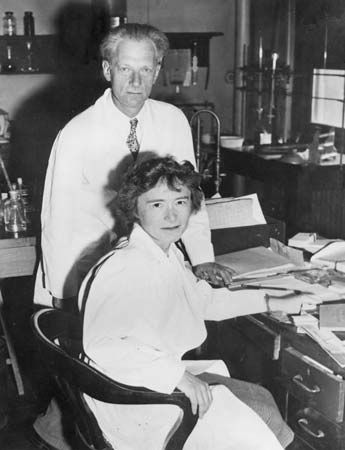Carl Cori and Gerty Cori
Our editors will review what you’ve submitted and determine whether to revise the article.
- In full, respectively,:
- Carl Ferdinand Cori and Gerty Theresa Cori
- Née:
- Radnitz
- Born:
- Dec. 5, 1896, Prague, Czech.
- Died:
- Oct. 20, 1984, Cambridge, Mass., U.S.
- Born:
- Aug. 15, 1896, Prague, Czech.
- Died:
- Oct. 26, 1957, St. Louis, Mo., U.S.
Carl Cori and Gerty Cori (respectively, born Dec. 5, 1896, Prague, Czech.—died Oct. 20, 1984, Cambridge, Mass., U.S.; born Aug. 15, 1896, Prague, Czech.—died Oct. 26, 1957, St. Louis, Mo., U.S.) were American biochemists, a husband-and-wife team whose discovery of a phosphate-containing form of the simple sugar glucose, and its universal importance to carbohydrate metabolism, led to an understanding of hormonal influence on the interconversion of sugars and starches in the animal organism. Their discoveries earned them (with Bernardo Houssay) the Nobel Prize for Medicine or Physiology in 1947.
They met while students at the German University of Prague and were married in 1920, receiving their medical degrees the same year. Immigrating to the United States in 1922, they joined the staff of the Institute for the Study of Malignant Disease, Buffalo, N.Y. (1922–31). As faculty members of the Washington University medical school, St. Louis (from 1931), they discovered (1936) the activated intermediate, glucose 1-phosphate (phosphate bound to a specific carbon atom on the glucose molecule), known as the “Cori ester.” They demonstrated that it represents the first step in the conversion into glucose of the animal storage carbohydrate glycogen, large quantities of which are found in the liver, and—because the reaction is reversible—in some cases the last step in the conversion of blood glucose to glycogen.
Six years later they isolated and purified the enzyme (glycogen phosphorylase) responsible for catalyzing the glycogen-Cori ester reaction, and with it they achieved the test-tube synthesis of glycogen in 1943. Proof of the interconversion allowed them to formulate the “Cori cycle,” postulating that liver glycogen is converted to blood glucose that is reconverted to glycogen in muscle, where its breakdown to lactic acid provides the energy utilized in muscle contraction. The lactic acid is used to re-form glycogen in the liver. Studying the way in which hormones affect carbohydrate metabolism in animals, the Coris showed that epinephrine induces the formation of a type of phosphorylase enzyme favouring conversion of glycogen to activated glucose and that insulin causes the removal of sugar from the blood by promoting the addition of phosphate to glucose. The Coris trained a large number of graduate students and postdoctoral fellows from all over the world.
After his wife’s death Carl Cori devoted his efforts to research concerning the physico-chemical action of enzymes involved in the breakdown of glycogen to lactic acid.









